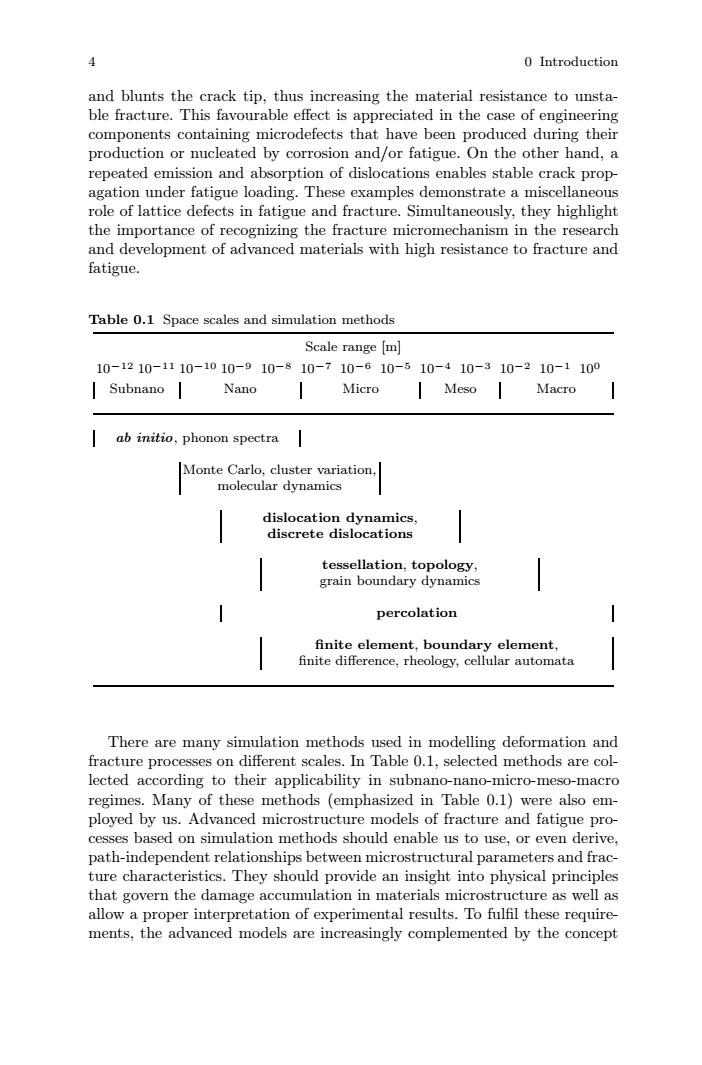正在加载图片...

0 Introduction and blunts the crack tip,thus increasing the material resistance to unsta- ble fracture.This favourable effect is appreciated in the case of engineering components containing microdefects that have been produced during their production or nucleated by corrosion and/or fatigue.On the other hand,a repeated emission and absorption of dislocations enables stable crack prop- agation under fatigue loading.These examples demonstrate a miscellaneous role of lattice defects in fatigue and fracture.Simultaneously,they highlight the importance of recognizing the fracture micromechanism in the research and development of advanced materials with high resistance to fracture and fatigue. Table 0.1 Space scales and simulation methods Scale range [m] 10-1210-1110-1010-910-810-710-610-510-410-310-210-1100 Subnano Nano Micro Meso Macro ab initio,phonon spectra Monte Carlo,cluster variation molecular dynamics dislocation dynamics, discrete dislocations tessellation,topology, grain boundary dynamics percolation finite element,boundary element. finite difference,rheology,cellular automata There are many simulation methods used in modelling deformation and fracture processes on different scales.In Table 0.1,selected methods are col- lected according to their applicability in subnano-nano-micro-meso-macro regimes.Many of these methods (emphasized in Table 0.1)were also em- ployed by us.Advanced microstructure models of fracture and fatigue pro- cesses based on simulation methods should enable us to use,or even derive, path-independent relationships between microstructural parameters and frac- ture characteristics.They should provide an insight into physical principles that govern the damage accumulation in materials microstructure as well as allow a proper interpretation of experimental results.To fulfil these require- ments,the advanced models are increasingly complemented by the concept4 0 Introduction and blunts the crack tip, thus increasing the material resistance to unstable fracture. This favourable effect is appreciated in the case of engineering components containing microdefects that have been produced during their production or nucleated by corrosion and/or fatigue. On the other hand, a repeated emission and absorption of dislocations enables stable crack propagation under fatigue loading. These examples demonstrate a miscellaneous role of lattice defects in fatigue and fracture. Simultaneously, they highlight the importance of recognizing the fracture micromechanism in the research and development of advanced materials with high resistance to fracture and fatigue. Table 0.1 Space scales and simulation methods Scale range [m] 10−12 10−11 10−10 10−9 10−8 10−7 10−6 10−5 10−4 10−3 10−2 10−1 100 Subnano Nano Micro Meso Macro ab initio, phonon spectra Monte Carlo, cluster variation, molecular dynamics dislocation dynamics, discrete dislocations tessellation, topology, grain boundary dynamics percolation finite element, boundary element, finite difference, rheology, cellular automata There are many simulation methods used in modelling deformation and fracture processes on different scales. In Table 0.1, selected methods are collected according to their applicability in subnano-nano-micro-meso-macro regimes. Many of these methods (emphasized in Table 0.1) were also employed by us. Advanced microstructure models of fracture and fatigue processes based on simulation methods should enable us to use, or even derive, path-independent relationships between microstructural parameters and fracture characteristics. They should provide an insight into physical principles that govern the damage accumulation in materials microstructure as well as allow a proper interpretation of experimental results. To fulfil these requirements, the advanced models are increasingly complemented by the concept